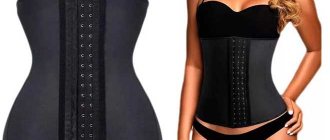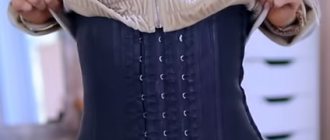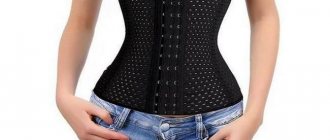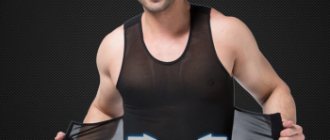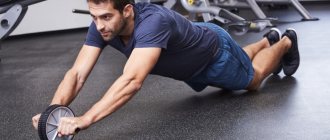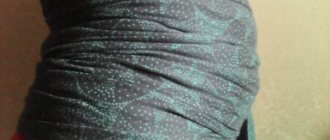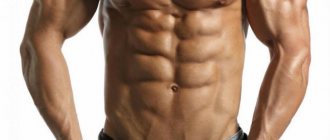Reduces waist size by 2 sizes, corrects posture, distributes the load on the back muscles. Can be used to restore your figure during the postpartum period.
This is an Italian brand of shapewear for women. Its basis is elastane. Microfiber, silicone bases, polyamide, jacquard, and antibacterial inserts are also used to make linen.
It has plastic inserts and a hook-and-eye closure on the back. The surface of the product itself is soft to the touch, silky. Has no seams, made of high quality microfiber.
The straps are thin, but do not stretch. Microfiber is all-season: it does not absorb moisture in summer and retains heat well in winter. This fabric is hygienic and breathable.
This material does not stretch, washes well, and creates a sauna effect. Instantly tightens the protruding belly, making a person slimmer. Provides a constant thermal effect, thereby removing excess liquid. It has a high degree of shrinkage and does not curl when worn. Thanks to the three-row fastener, the tightening force can be changed.
The inner cotton layer makes the product very comfortable to wear.
Suitable for everyday use. Forms a beautiful silhouette, improves posture, and does not disrupt blood flow in the body. In the production of underwear of this brand, technologies of the large pharmaceutical company Bayer are used. It is impregnated with a special composition that can withstand up to 50 washes: chamomile extract, sea fish liver extract, hot pepper extract.
Post navigation
Used to tighten the abdominal area. The belt is completely invisible under underwear, even under light summer clothes. Due to impregnation, it further enhances fat burning. Tightens the stomach while relaxing and toning the muscles.
Can be used after training. Corrects posture, strengthens back muscles, tightens arms, reduces waist, lifts chest.
In the old days, girls wore a high belt with a rigid frame and spiral-shaped ribs-bones for visual correction of the figure. Then it began to be used in orthopedics to maintain the spine in the correct anatomical shape. And recently, a corset for weight loss has become increasingly popular, promising not only a visual reduction in volume, but also weight loss. Due to thermogenesis and increased sweating, toxins are released in the area of the problem part of the body and adipocytes are destroyed. The created sauna effect eliminates excess fluid and swelling.
Due to impregnation, it ensures fat burning in the area where the T-shirt comes into contact with the skin. A special tightening corset belt must be selected carefully, taking into account several factors. The main one is waist circumference. Taking into account its volume, the size of the corset is selected. If you do not plan to play sports in it, then the product should be 10-15 cm narrower. The width of the belt is determined by the line where the sides meet. Other selection criteria:.
There are differences in body fat between men and women. In representatives of the stronger sex it is less porous and elastic.
What is a weight loss corset?
The classic corset's popularity peaked in the 1800s. As a fashionable piece of underwear, it comes back from time to time
The classic corset's popularity peaked in the 1800s. As a fashionable piece of lingerie, it comes back from time to time. Since the late 1990s, a corset has appeared in the wardrobe of a modern woman as an item of outerwear (corset belt), worn over blouses and dresses.
As a means of losing weight, the corset appeared in the early 2000s. With the development of modern materials and technologies, the weight loss corset is becoming more and more effective. At the same time, the term “corset diet” appeared. It means losing weight with a corset and is not related to nutrition, although it is called a diet. The corset diet means wearing a corset for several hours a day (from 3 to 6 hours), which can reduce the waist by an average of 4-5 inches.
The shape of a weight loss corset resembles a classic corset, but is intended solely for losing weight in the waist area, and does not have as its goal lifting the chest and shaping the bust. A weight loss corset is an item made of thick fabric with a zipper, Velcro or loops.
Description and types of products
A posture corrective corset is an orthopedic product consisting of several elements that provide reliable fixation. The materials from which bandages are made are most often durable elastic fabrics, specialized plastic, as well as various metals (in the case of correctors with increased rigidity). All materials must be hypoallergenic.
For each type of curvature of the spinal column, it is necessary to select an individual corset model that meets therapeutic criteria. One of the most important differences between posture correctors is the rigidity of the fixation. The following types are distinguished.
- Soft posture correctors. They are products made from elastic hypoallergenic fabrics. Wearing models of this type is most often prescribed by doctors for minor curvatures of the spine. Their use is also justified for the prevention of diseases of the musculoskeletal system and postural disorders.
- Semi-rigid bandages. The products are equipped with fasteners and additional stiffening ribs made of plastic. Such modifications are necessary to provide additional support for more severe postural problems.
- Rigid spinal corsets. They are equipped with stiffening ribs made of plastic or metal, adjustable belts and fasteners. They are used for the treatment of complex curvatures of the spinal column, in the complex treatment of a number of severe pathologies of the musculoskeletal system.
Another important factor is the location of the product on the body. Based on this criterion, the following types of devices are distinguished:
- lumbar
- thoracolumbar;
- chest
There are magnetic reclinators and electronic posture correctors, but such products cannot be made at home due to the complexity of the design.
How it works
It is believed that a corset can reduce waist size when worn for a long time. This is achieved due to several factors: firstly, a tight corset reduces volume, and secondly, sweat helps remove toxins and lose weight. Corsets promote more intense sweating during training, the so-called bath effect is observed, and this allows you to lose weight faster. Thirdly, corsets force you to eat less, as internal organs are compressed, and excess food brings discomfort.
The effectiveness of weight loss depends on the quality of the corset. There are latex models, microfiber, rubber, thick knitwear. The more sweat you produce, the more fat you will lose - this is what manufacturers believe.
There are corsets that are recommended to be worn only during training, but there are also models that should be worn during everyday life: at work, at home, on vacation.
Sequence of actions when making a corset
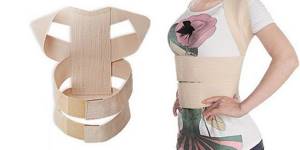
To make a posture corrector, a person must have sewing and cutting skills. Correctly drawn up recess drawings will ensure that the result obtained corresponds to the desired one. You can use ready-made patterns from the Internet, but in this case it is impossible to make a bandage that meets all the requirements and requests.
To properly make a corset to correct posture at home, you need the following.
- Select materials. Fabrics should breathe, be elastic, washable and not wrinkle when worn. Only hypoallergenic materials should be selected.
- To determine the undercuts, it is necessary to take measurements of the chest, waist and hips.
- Draw a pattern diagram.
- Transfer it to the fabric, respecting the scale.
- Each element of the posture corrector must be carefully cut and ironed.
- Secure the corset pieces with pins.
- Use thin and strong threads to sew the components of the bandage together.
- To fasten the elements, use a high-quality sewing machine.
- After stitching the edge, the product must be tucked (preferably with an overlocker).
Waist training corset
Why you shouldn't wear corsets for waist training if you value yourself and your life. Opinion of a doctor, fitness trainer, burlesque diva and Cilantro.
The waist training corset is a wildly popular thing. Search for waist training corset or waist training on Instagram and see: hundreds of thousands of girls around the world want to be not just slimmer, but narrower in the middle of their torso. “I have 23!” - “And I have 21!” - write in the comments. No, it’s not the men, amazed by the beauty of the ladies in the photo, who measure their members, but the girls who measure their waist circumference in inches.
The catalysts for the corset hysteria can be considered Kim Kardashian and her endless Kardashian-Jenner sisters, which we have no strength to understand. Of the decent ladies, Jessica Alba admitted that she used a “corset diet” after pregnancy. And then she spilled the beans once in an interview and has been prudently silent ever since. The British press suspects that Gwyneth Paltrow sometimes wants to get involved, but does not provide any evidence.
Most of the celebrities in corsets are Instagram stars or people like Amber Rose or Snooki. The first one has the usual set in the “work” column: model, designer, actress, singer (whoever remembers her song or role without Google will have a pie off the shelf), the second one is an American reality show star.
And yes, they do sleep in them, like Penny “Underbust” Brown, who shrunk her body from 96.5cm to 58.8cm. On the other hand, she also enlarged her breasts to size O. With such a remarkable appearance, she is a star in Japan. We can say that Penny has a production need, albeit at the risk of her life.
No, I will not say that it is not useful. And even more so to exaggerate: “Oh, the women of the Victorian era were suffocating, tightly compressed by whalebone and metal plates.” We were suffocating, of course, but let’s not write off tuberculosis and other infectious diseases, unsanitary conditions and the lack of antibiotics. They were probably the root cause, and the corsets simply made the situation worse.
I just want to ask: why? Why do we women need an extremely thin, emphasized waist? The answer would seem obvious: firstly, it is beautiful. Because it's feminine. And why?
The contrast between the waist and hips indicates an estrogenic body type, which is also, in general, the most promising for those who are thinking about where to place their seed
Have you ever wondered why the waist has been valued since time immemorial? The simplest answer is that it is an obvious visual indicator that the female is not pregnant. Well, you know, the Stone Age, it’s somehow inconvenient to ask. At the same time, you don’t want to feed someone else’s offspring, and the real father may return. In general, if there is a waist, the woman is free and you can gift her with your sperm. Wild people!
The second point is also related to procreation. The contrast between the waist and hips indicates an estrogenic body type, which is also, in general, the most promising for those who are thinking about where to place their seed.
By the 19th century, men in theorizing their erotic preferences had reached the point where they managed to find medical justifications for the benefits of corsets - they not only straighten the back, but also streamline a woman’s thoughts. She, the fool, won’t figure out her thoughts on her own.
Therefore, when in the 21st century a woman wears a “training corset” to work, the gym and dates and says that it is her personal choice what to do with her body, I want to ask again: are you sure? Is this not at all because it has long been ingrained in the public consciousness that a narrow waist makes us more desirable as females?
And, by the way, a set of celebrities in corsets confirms my point. Cate Blanchett and Tilda Swinton don't post gym selfies in pink corsets. Marissa Mayer, mother of three children and CEO of Yahoo, did not give interviews after giving birth that she returned to shape thanks to a miracle iron.
What did Kim Kardashian do for hip-hop in her years, besides marrying Kanye? Does she sing amazingly? Inspires people with paintings? Fighting cancer?
For me, as soon as the desire arises to measure your value to humanity in centimeters, you urgently need to be distracted by something useful. To bake a cake. Learn a poem. Do 10 squats. Wash the floor. You look, and he will let go.
How to choose a lumbosacral corset?
To choose the right product, you need to consult with an orthopedist. Belts are available in varying degrees of rigidity. You should refer to the size charts of product manufacturers. If you are interested in how to choose the right size for a lumbar corset, we offer basic recommendations: measure your waist and hips; divide the sum of the two measurements by two, the result will correspond to the size of the corset; Some manufacturers indicate the size by waist circumference, others - by lower back circumference (measure 8 cm below the waist).
Size table by average volume

Size chart with differences for men and women
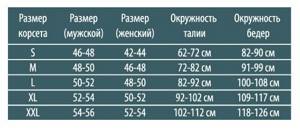
For comfortable wearing and the effectiveness of the corset, choose a model made of elastic and durable fabric that has pores for air circulation. It is pleasant and convenient to use products made from natural materials. The most comfortable one is a knitted corset, which does not stand out under clothes. The mesh structure allows the skin to breathe and the body does not sweat.
The rigidity and degree of fixation is determined by the doctor depending on the patient’s condition. A rigid corset is recommended for severe pain radiating to the groin and buttocks. The products are prescribed for exacerbation of osteochondrosis, spinal injuries, and intervertebral hernias. The device is designed for complete fixation, it helps to unload and stabilize the vertebrae. Semi-rigid models are effective for relieving pain due to radiculitis and vertebral displacement. They are worn in the postoperative period.
Is it harmful to wear a corset?
There are a number of persistent myths surrounding corsets, dating back to times when there was not such a wide range of environmentally friendly materials and in-depth knowledge in the field of human structure.
Today, corsets are sewn taking into account the anatomy and do not affect the internal organs. Even a strong tightening is distributed in such a way as not to compress the vessels, and especially not to contribute to muscle atrophy.
Moreover, with a reasonable approach, the body gradually gets used to the corset. And there are even certain rules for wearing corsets: you need to start with an hour a day with a slight tightening, and then every day increase the wearing time and the degree of tightening.
What is needed to properly manufacture a product?
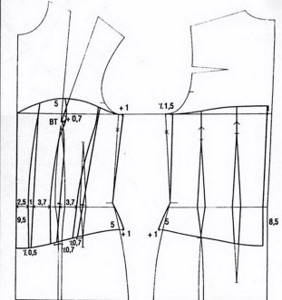
To make a quality posture corrector with your own hands, you need to have an idea of the final type of device. You should visit an orthopedic salon and examine in detail the factory design of the corsets. This way you will be confident in the style, level of rigidity and algorithm of actions when making your own corrector.
In order to create a corset, you must follow the rules:
- determine the location of the curvature of the spine to create the desired model of the product;
- select hypoallergenic materials in the proper quantity (it is advisable to take more than necessary);
- record the measurements to create a product that provides reliable posture support;
- purchase and master a high-quality sewing machine;
- learn how to make professional paper patterns that take into account the structural features of your figure.
Ready-made patterns can be used for posture corrector models in the future. Also, the knowledge described above will help in creating spinal bandages for adults and orthopedic corsets for children.
Why can you lose weight in a corset?
So that the figure can gradually change, the corset is given the necessary shape with the help of individual patterns and special materials, to which the body gets used to over time, resulting in a reduction in the waist.
In addition, constantly wearing a corset regulates food intake and prevents you from overeating - try stuffing a third bun or ice cream into yourself when your stomach is in a slightly cramped position. Over time, you get used to eating less, so weight loss can easily be called a side effect of wearing a corset!
But don’t think that a corset is only for the overweight; many fairly thin girls with an “apple” or “rectangle” body type can train in the gym around the clock and eat only lettuce leaves, but they still won’t have a thin, emphasized waist. In such cases, a corset comes to the rescue.
“As for losing weight, such corsets do not contain special materials that allow the skin to breathe, but at the same time create a greenhouse effect and promote the evaporation of moisture. In this case, the corset can visually correct the figure, but when you take it off, everything will return to its place. The only way you can lose weight when wearing a corset for a long time is because eating a lot will be uncomfortable. It’s not for nothing that in dietetics they talk about fractional meals - eat less, but more often, which does not lead to overstretching of the stomach.”
Foam
There are even special bath foams on sale for those who want to lose weight. There is nothing supernatural in this product, it is an ordinary hygiene item, only it contains components that remove excess water from the body and speed up metabolic processes. Cosmetics may also contain minerals, plant extracts and extracts that tighten the skin, making it more elastic and firm.
Chinese websites even sell special foam, which is similar in consistency to shaving foam. Manufacturers promise that after using it, even the most saggy and ugly belly will “go away”.
It is impossible to say for sure whether marketers are telling the truth. It is unlikely that “miracle remedies” will help get rid of fat deposits, and it is not known what harm they will cause to the body after losing weight.
Does a corset help you burn fat?
To understand whether a corset helps burn fat, let's figure out how this actually happens. Let's start with the term itself - “burning”. Here semantics forms the basis of many misconceptions.
If the body does not have enough energy to contract muscles, then a chemical process occurs, as a result of which subcutaneous fat is broken down, its molecules are transferred with the blood to the muscles and there they are oxidized in the mitochondria in the presence of oxygen. As a result, energy is synthesized.
That is, the only condition for the use of fat reserves is a lack of energy in the body from food. What is the combustion process? Essentially a chemical oxidation reaction involving oxygen. This is where the term “burn fat” comes from. At the same time, the process of fat oxidation has nothing to do with external temperature. We are warm-blooded, our body is designed to maintain homeostasis - constant conditions.
If it heats up under the influence of external factors, as happens when training in an overheated room, when using sauna belts and the same corsets, then the body will either cool down in response (this causes us to actively sweat under the corset) or stop moving. By increasing body temperature with a corset, we only achieve fluid loss through sweat.
And this is rather bad for training: blood rheology decreases (that is, the blood becomes more viscous), and the beneficial processes characteristic of active physical activity are inhibited. If body temperature rises, performance decreases, which means we will not work the muscles properly and will burn fewer calories during the workout. Lost fluid must be restored. It turns out that the corset sabotages our attempts to use fat reserves on many levels.
- A full workout is impossible without sufficient oxygen supply and proper breathing, which is not always possible with a chest compressed by a corset
Local burning of fat in the waist area is basically impossible. Roughly speaking, the body “decides” where exactly to break it down.
- A full workout is impossible without sufficient oxygen supply and proper breathing, which is not always possible with a chest compressed by a corset. Here, at a minimum, you won’t train properly, and your body won’t develop properly. There is every chance of losing consciousness. This is quite unsafe in the gym, especially during weight training. If the issue of losing weight is relevant, then remember: “fat burning” - oxidation - requires the presence of oxygen. Oxygen is essential for metabolism, and there are documented cases where wearing a corset causes metabolic disruption, leading to even more weight gain.
- As for the idea of wearing a corset all the time and even sleeping in it. The corset muscles (back and abdominal muscles) work isometrically to maintain an upright body position when we sit or stand. If we turn and bend, these muscles contract concentrically and eccentrically. Even when we are lying down, they work - they seem to “push off” from the surface on which we are lying. The more muscles are unloaded, the worse their condition will be. If you don't use it – you loose it. What you don't use atrophies. If this work - even if only an isometric contraction - is taken over by a corset, then the muscles of the back and abdomen, of course, become weaker. Possible consequences of muscle weakening are umbilical hernia (a very dangerous condition), diastasis in women after pregnancy (separation of the rectus abdominis muscles), back pain.
- Medical corsets are a great invention for those who already have problems. Exactly the same as glasses for the visually impaired, hearing aids for the hearing impaired, crutches for leg injuries. But replacing healthy – for now – organs (muscles are also an organ), thereby causing their degradation, is hardly commendable.
Bandages
The design of these orthopedic products is very simple. They look like elastic belts and are fixed on the thoracic or lumbar spine. Bandages are used to support the back and relieve certain muscle groups. They help reduce pain that occurs due to certain diseases, injuries or surgeries. They are also worn to prevent possible injuries or damage when performing heavy physical work or active sports.
Conventional spinal braces provide a weak degree of fixation. Some models are additionally equipped with metal and/or plastic elements that create a rigid frame and contribute to more reliable fixation and stabilization of the spine.
Bandages can be used without a doctor’s prescription, but consultation with a specialist will help you choose the right model and determine the optimal period of wearing the orthosis.
The effectiveness of a corset for weight loss
Fabric products with special impregnation reduce weight.
- By wearing a corset after taking a bath, you can not only improve the condition of the epidermis, but also reduce the appearance of orange peel.
- The body becomes toned due to tension, and thanks to muscle memory, you will notice significant improvements in your figure.
- You can call a corset a home remedy against cellulite and excess weight. The impregnation is effective until the first wash, so after this the product will lose its fat-burning characteristics.
If we talk about corsetry, which is offered by manufacturers from Italy and America, then it has a visual retraction effect. Expensive goods are designed to be worn under outerwear.
It is not recommended to wear tight underwear for more than three to four hours a day, otherwise blood circulation in the body may be impaired.
Contraindications for wearing tight corsets are:
Fragile and slender ladies in the Middle Ages could easily faint precisely because they were wearing a “shell” for weight loss.
Corsets that are too tight can certainly harm your health:
- However, manufacturers of special underwear have made sure that wearing modern products is as comfortable as possible for the fair sex.
- To lose weight in the abdomen and sides, there is a special weight loss belt that affects specific areas.
A convenient and useful thing - a weight loss corset - will help reduce body volume and tone it. However, only physical activity and diet can really help you achieve significant changes and get your figure in shape.
Reclinators
A reclinator is a posture corrector that turns the shoulders and helps fix the spine in the upper thoracic region. Use it for:
- preventing slouching or combating it;
- forming the habit of keeping your back straight and your shoulders turned;
- alignment of posture.
Externally, posture correctors are an eight-shaped design, the loops of which are put on the shoulders. A properly sized reclinator securely fixes the clavicular region, preventing a child or adult from slouching.
Another indication for the use of reclinators is a fracture of the collarbone. The orthosis supports the injured area, limits movement and promotes a speedy recovery.
To use the reclinator to be as effective as possible, it must be worn daily, starting from a few minutes and gradually increasing the time to 5-6 hours a day. A specialist should develop a schedule for wearing the orthosis and determine the duration of therapy.
Corset VS shapewear
The effect of a corset is often compared to shapewear. And despite the fact that these things have the same purpose and a single goal in theory, in practice they cope with the task in different ways.
Shapewear is such an easy version of correction when you just need to smooth out small volumes or wrinkles. Moreover, not all representatives of this class can cope with this task. And the corset performs much more functions: it will not only tighten you, but with regular use it will reduce your waist in centimeters, straighten your posture, curb your appetite and promote weight loss.
And by the way, many women feel awkward if their shapewear accidentally flashes before someone’s gaze, while a corset decorated with beautiful lace, on the contrary, looks very impressive.
A burlesque diva's opinion on wearing a corset
I really love the silhouette of clothes with an accentuated waist, be it a belt or a corset, but is a loose, high-waisted empire silhouette less feminine? This is a matter of taste and organic selection of clothes to match how the girl sees herself. Even in burlesque, which may seem to many to be the epitome of old-fashioned femininity, not everyone uses corsets. Personally, the “rectangular” silhouette of the 1920s, where the waist and hip lines are draped by a loose dress, is much closer to me for the stage.
I have two stage corsets, both made to order to my measurements. If the corset is well sewn, it does not restrict movement; rather, it feels like a very, very tight hug.
The moment of the first fitting is usually quite painful, but after that the body and the corset get used to each other, you understand how tightly it should be laced, whether something needs to be hemmed from the inside, whether the bones are digging into the body somewhere, whether the cord needs to be replaced with tape or vice versa.
I am often asked if I would like to be born in a different era. And I always answer that, of course not. Of course, I am incredibly interested in the aesthetics of the 1920s, the music of the 1930s and the literature of the 1980s, but right now you can wear a corset and be a feminist, or cut your hair very short, fundamentally not shave your armpits and at the same time be a housewife, a mother of three children, or work as a lawyer during the day, and in the evening to dance burlesque.
I don't think that girls who choose to wear a corset in everyday life do so for the sake of men or to conform to traditional canons of femininity. Rather, it is the desire to look the way you yourself consider beautiful and interesting, to turn into an ideal version of yourself. And this usually means quite strong self-discipline, attention to detail and absolute freedom of choice. All my extravagant acquaintances regularly laugh and talk about how men tell them that they look more interesting and “more real” in jeans and without makeup.

